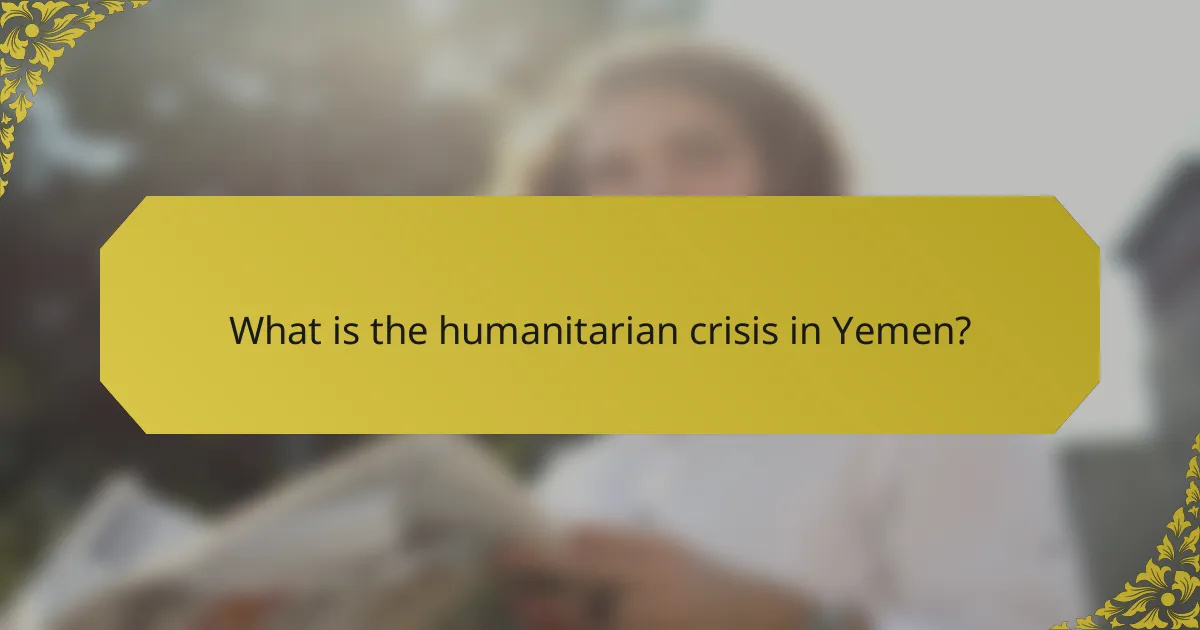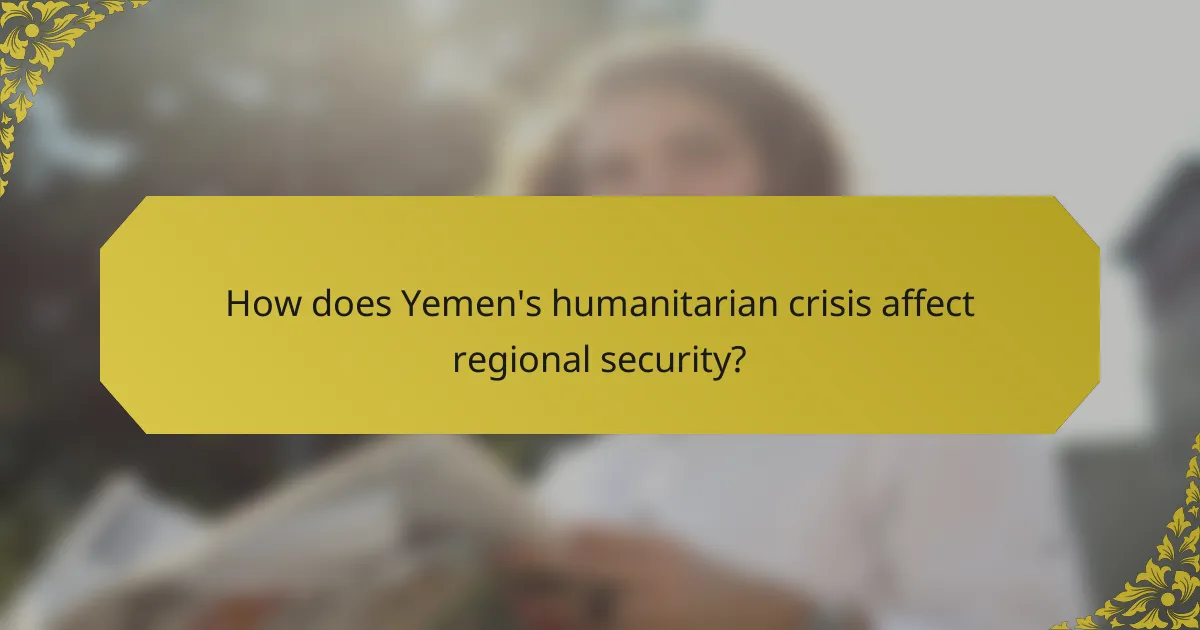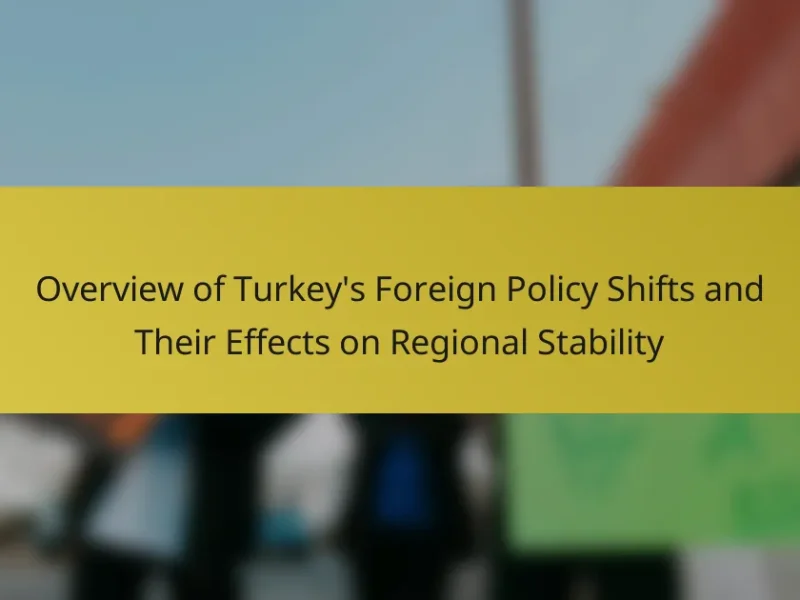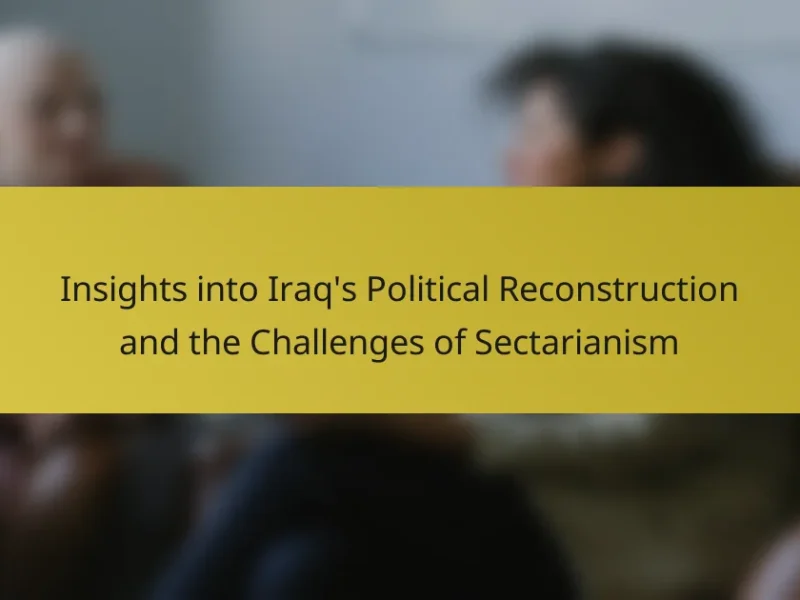
What is the humanitarian crisis in Yemen?
The humanitarian crisis in Yemen is a severe situation resulting from prolonged conflict, famine, and disease. Since 2015, the civil war has led to widespread destruction and displacement. Over 24 million people, nearly 80% of the population, require humanitarian assistance. The conflict has created a cholera outbreak, with over 2 million suspected cases reported. Food insecurity is rampant, with millions facing acute malnutrition. Access to clean water and healthcare is critically limited. The crisis has prompted international responses, yet funding remains inadequate. Yemen is considered one of the world’s worst humanitarian crises, according to the United Nations.
How did the humanitarian crisis in Yemen develop over time?
The humanitarian crisis in Yemen developed due to a combination of conflict, economic collapse, and deteriorating living conditions. The crisis escalated in 2014 when Houthi rebels seized control of the capital, Sana’a. This led to a civil war, drawing in regional powers like Saudi Arabia and Iran. The conflict has caused widespread destruction of infrastructure and essential services. As of 2021, over 24 million people in Yemen required humanitarian assistance. The United Nations classified Yemen as one of the worst humanitarian crises globally. Food insecurity and malnutrition rates have surged, with millions facing famine conditions. The ongoing violence has hindered aid delivery and worsened the situation for civilians.
What key events have contributed to the worsening situation in Yemen?
The key events contributing to the worsening situation in Yemen include the outbreak of civil war in 2015. This conflict escalated following the Houthi movement’s takeover of the capital, Sana’a. The subsequent Saudi-led coalition intervention further intensified the violence. Blockades imposed by the coalition have severely restricted humanitarian access. The economic collapse has led to widespread poverty and famine. Additionally, the ongoing conflict has resulted in a health crisis, with diseases like cholera spreading rapidly. International aid efforts have been hampered by security concerns and logistical challenges. These events collectively exacerbate the humanitarian crisis in Yemen.
What are the current statistics reflecting the humanitarian crisis in Yemen?
As of 2023, approximately 24 million people in Yemen require humanitarian assistance. This figure represents about 80% of the country’s population. The United Nations reports that 4.5 million children are acutely malnourished. Additionally, 17.4 million people lack access to clean water and sanitation. The ongoing conflict has displaced over 4 million people since 2015. Health services are severely disrupted, with 50% of health facilities non-functional. The humanitarian crisis has led to a cholera outbreak, with over 2.5 million suspected cases reported since 2016. These statistics underscore the dire situation in Yemen and the urgent need for international aid.
What are the primary causes of Yemen’s humanitarian crisis?
The primary causes of Yemen’s humanitarian crisis include ongoing conflict, economic collapse, and blockade. The civil war, which began in 2015, has led to widespread violence and displacement. Millions of people have been forced to flee their homes. Economic collapse has resulted in soaring unemployment and inflation. Many Yemenis lack access to basic services and necessities. The blockade imposed by Saudi-led coalition forces restricts the flow of food and medical supplies. This exacerbates malnutrition and disease outbreaks. According to the United Nations, over 24 million people require humanitarian assistance in Yemen.
How do political conflicts impact the humanitarian situation in Yemen?
Political conflicts severely worsen the humanitarian situation in Yemen. Ongoing violence disrupts access to essential services. This includes healthcare, food, and clean water. The conflict has led to widespread displacement of civilians. Over 4 million people have been uprooted from their homes. Economic collapse further exacerbates food insecurity. Approximately 16 million people are facing acute hunger. Blockades hinder the delivery of humanitarian aid. This results in increased suffering for the population. The United Nations has called Yemen the world’s worst humanitarian crisis.
What role do economic factors play in exacerbating the crisis?
Economic factors significantly exacerbate Yemen’s humanitarian crisis. High unemployment rates lead to increased poverty levels. Limited access to essential goods drives up prices, making food and water scarce. Inflation has surged, diminishing the purchasing power of families. The ongoing conflict disrupts trade and economic activities. These disruptions hinder humanitarian aid delivery and worsen living conditions. According to the World Bank, Yemen’s economy contracted by 50% since the conflict began. This economic collapse fuels instability and insecurity in the region.

How does Yemen’s humanitarian crisis affect regional security?
Yemen’s humanitarian crisis significantly destabilizes regional security. The ongoing conflict has led to widespread famine and displacement. This instability can fuel extremist groups in the region. For example, Al-Qaeda and ISIS have exploited the chaos to expand their influence. Additionally, the humanitarian crisis strains neighboring countries. It increases the burden of refugees and resources. Countries like Saudi Arabia and Oman face security challenges due to spillover effects. The crisis also complicates diplomatic relations in the region. Overall, Yemen’s humanitarian situation directly impacts the security landscape of the Middle East.
What are the implications of the humanitarian crisis for neighboring countries?
The humanitarian crisis in Yemen significantly impacts neighboring countries. Increased refugee flows strain resources in countries like Saudi Arabia and Oman. These nations face heightened security concerns due to potential instability. Humanitarian needs may divert attention and resources from regional security efforts. Economic pressures arise as neighboring countries provide aid and support. Diplomatic relations can be tested as nations respond differently to the crisis. The crisis also raises concerns about cross-border health risks, such as disease outbreaks. Overall, the implications are multifaceted, affecting security, economy, and diplomacy in the region.
How does the influx of refugees from Yemen impact regional stability?
The influx of refugees from Yemen significantly undermines regional stability. Increased refugee numbers strain resources in host countries. This can lead to social tensions and competition for jobs. Neighboring nations may face challenges in providing adequate services. Humanitarian needs often exceed available aid, causing further instability. In 2021, over 4 million Yemenis were displaced, exacerbating regional pressures. Countries like Saudi Arabia and Oman experience heightened security concerns. These dynamics can also foster extremist groups exploiting instability. Overall, the refugee crisis intensifies existing regional conflicts and complicates diplomatic efforts.
What security threats arise from the ongoing conflict in Yemen?
The ongoing conflict in Yemen poses multiple security threats. These include the rise of extremist groups, such as Al-Qaeda and ISIS, which exploit the chaos. The conflict has led to a humanitarian crisis, increasing instability in the region. Additionally, the proliferation of weapons among various factions raises the risk of violence. Cross-border attacks have also escalated, threatening neighboring countries. The ongoing war has created a power vacuum, making it difficult to establish governance. This instability can lead to increased refugee flows, impacting regional security. The humanitarian situation further complicates international aid efforts, hindering effective responses.
How do regional powers respond to Yemen’s humanitarian crisis?
Regional powers respond to Yemen’s humanitarian crisis through diplomatic efforts, humanitarian assistance, and military involvement. Countries like Saudi Arabia and the UAE provide substantial financial aid and supplies to alleviate suffering. They also engage in diplomatic negotiations to seek resolutions to the ongoing conflict. Additionally, these nations participate in military operations against Houthi forces, which complicates humanitarian access. Iran, supporting the Houthis, influences the crisis by providing military and logistical support. This involvement by regional powers impacts both the humanitarian situation and regional security dynamics. The ongoing conflict has led to one of the world’s worst humanitarian crises, with millions in need of assistance.
What are the strategic interests of regional actors in Yemen?
Regional actors in Yemen have strategic interests primarily centered around geopolitical influence, security concerns, and economic resources. Saudi Arabia aims to counter Iranian influence in the region. It views the Houthis as a proxy for Iran and seeks to maintain its dominance in the Arabian Peninsula. The UAE focuses on securing maritime routes and establishing a foothold in southern Yemen. This aligns with its broader strategy to enhance its regional power. Iran’s interest lies in expanding its influence through support for the Houthis, which serves its goal of challenging Saudi Arabia. These actors are also motivated by access to Yemen’s resources, including oil and gas reserves. Control over these resources can significantly impact their economic stability and regional power dynamics. The ongoing conflict exacerbates humanitarian crises, affecting regional security and international aid efforts.
How do alliances and rivalries shape responses to the crisis?
Alliances and rivalries significantly influence responses to the humanitarian crisis in Yemen. Nations aligned with the Saudi-led coalition often support military actions and provide humanitarian aid. For instance, the United States has backed Saudi Arabia, contributing to military resources and logistical support. Conversely, rival nations like Iran have provided support to the Houthi rebels, complicating the situation. This rivalry leads to a fragmented response to humanitarian needs. Additionally, regional alliances can dictate the flow of aid, as allied nations may prioritize their interests over neutral humanitarian efforts. The geopolitical landscape thus shapes the effectiveness and reach of international aid in Yemen.

What is the role of international aid in addressing Yemen’s humanitarian crisis?
International aid plays a critical role in addressing Yemen’s humanitarian crisis. It provides essential resources such as food, medical supplies, and clean water. The United Nations estimates that over 24 million people in Yemen require humanitarian assistance. Aid organizations deliver support to vulnerable populations affected by conflict and famine. International funding helps sustain health services and prevent disease outbreaks. Moreover, aid initiatives aim to rebuild infrastructure damaged by war. Countries and NGOs collaborate to ensure aid reaches those in need. This assistance is vital for stabilizing the region and preventing further escalation of the crisis.
How effective are international aid efforts in Yemen?
International aid efforts in Yemen have been moderately effective but face significant challenges. The ongoing conflict and blockades hinder the delivery of essential supplies. Despite this, aid organizations have provided critical support, reaching millions with food and medical assistance. According to the UN, around 24 million people require humanitarian aid. Funding shortfalls also impact the scale and sustainability of aid. In 2021, the UN reported a 50% decrease in funding compared to previous years. This has led to worsening conditions for many Yemenis. Therefore, while international aid efforts are crucial, their effectiveness is limited by various obstacles.
What challenges do aid organizations face in delivering assistance?
Aid organizations face multiple challenges in delivering assistance. These include security risks, logistical difficulties, and funding shortages. In conflict zones like Yemen, security threats hinder access to affected populations. Aid workers often encounter violence, making it dangerous to operate. Logistical challenges arise from damaged infrastructure and transportation issues. Many areas lack roads or are inaccessible due to conflict. Additionally, funding shortages limit the resources available for aid efforts. Organizations often rely on donations, which can fluctuate. Bureaucratic obstacles also complicate operations. Regulatory requirements can delay the delivery of essential supplies. These challenges collectively impede the effectiveness of humanitarian assistance in Yemen.
How do funding shortages impact humanitarian efforts in Yemen?
Funding shortages severely hinder humanitarian efforts in Yemen. These shortages lead to reduced access to essential services. Food, healthcare, and clean water become scarce due to lack of financial support. Over 24 million people in Yemen require humanitarian assistance. Many aid organizations have had to scale back operations. This reduction exacerbates the humanitarian crisis and increases suffering. Without adequate funding, malnutrition rates rise, and diseases spread. The lack of resources also limits the ability to respond to emergencies.
What are the key international organizations involved in Yemen’s aid efforts?
The key international organizations involved in Yemen’s aid efforts include the United Nations (UN), the World Food Programme (WFP), and the International Committee of the Red Cross (ICRC). The UN coordinates humanitarian assistance and provides funding for various relief initiatives. The WFP focuses on food security, delivering vital food aid to millions in Yemen. The ICRC offers medical assistance and supports healthcare facilities amidst the ongoing conflict. These organizations play crucial roles in addressing the humanitarian crisis in Yemen, which has resulted in widespread displacement and food insecurity.
What specific programs are being implemented by these organizations?
It is not possible to provide a definitive answer regarding the specific programs being implemented by organizations in Yemen’s humanitarian crisis without access to current data or reports. Organizations like the United Nations and various NGOs typically implement programs focused on food security, healthcare, and shelter. However, the specifics can vary widely and are subject to change based on the evolving situation. Detailed information would require direct references to organizational reports or databases that outline these programs.
How do these organizations coordinate their efforts in Yemen?
Organizations coordinate their efforts in Yemen through collaborative frameworks and shared communication channels. They establish joint task forces to streamline operations and avoid duplication of efforts. Regular coordination meetings facilitate information sharing among various agencies. These organizations often utilize centralized databases to track resources and needs in real-time. Coordination is further enhanced through partnerships with local NGOs for on-ground insights. International bodies like the UN play a crucial role in mediating between different organizations. Their efforts are aimed at maximizing the impact of humanitarian aid. According to the UN Office for the Coordination of Humanitarian Affairs, effective coordination is vital due to the complex security environment in Yemen.
What best practices can improve international aid efforts in Yemen?
Enhancing international aid efforts in Yemen requires a multi-faceted approach. Coordination among various aid organizations is crucial. Effective communication ensures that resources are allocated efficiently. Prioritizing local partnerships can improve the contextual relevance of aid. Implementing data-driven assessments can identify the most urgent needs. Regular monitoring and evaluation of aid effectiveness are essential for accountability. Adapting aid strategies based on feedback from beneficiaries fosters trust and engagement. Finally, securing sustainable funding sources is vital to maintain ongoing support. These practices are supported by reports from organizations like the United Nations, which emphasize the importance of coordinated efforts in crisis response.
The main entity of the article is Yemen’s humanitarian crisis, which has profound implications for regional security and international aid efforts. The article outlines the severe humanitarian situation in Yemen, marked by conflict, famine, and disease, affecting over 24 million people. It discusses the historical development of the crisis, key events that have worsened conditions, and the role of political and economic factors. The impact of Yemen’s crisis on neighboring countries and the response of regional powers are examined, alongside the challenges faced by international aid organizations in delivering assistance. Finally, best practices for improving aid effectiveness are highlighted to address the ongoing humanitarian needs.


